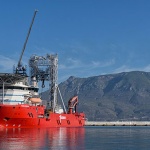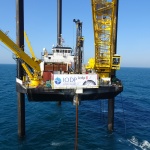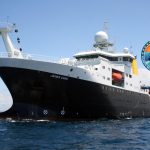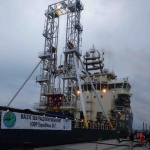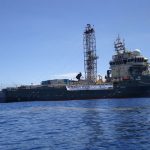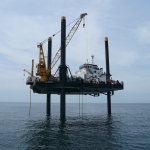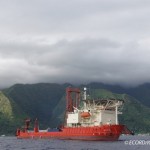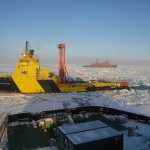The Role of Mission-Specific Platforms in IODP
Since the start of the Integrated Ocean Drilling Program (IODP) in 2003, the ambitious expansion of scientific exploration beneath the oceans has been made possible by the increased drilling capability provided by multiple platform operations. The IODP Platform Provider in Europe is the ECORD Science Operator (ESO). ESO conducts mission-specific platform (MSP) expeditions for the IODP and has carried out eight MSP expeditions all around the globe: in ice-covered waters of the Arctic; in shallow waters around Tahiti, off the coast of New Jersey (USA), next to the Australian Great Barrier Reef, in the Baltic Sea and off the coast off Yucatan in the crater of Chicxulub; in deep waters of the mid-Atlantic Ocean (Atlantis Massif) and the Gulf of Corinth in the Mediterranean Sea.
Watch videos from MSP expeditions on YouTube – ECORD-IODP channel.
- Fugro Synergy, Exp 381
- L/B Myrtle, Exp 364
- RRS James Cook, Exp 357
- Greatship Manisha, Exp 347
- Greatship Maya, Exp 325
- L/B Kayd, Exp 313
- DP Hunter, Exp 310
- I/B Vidar Viking, Exp302
What is a Mission-Specific Platform?
Whereas the US and Japanese ships, JOIDES Resolution and Chikyu, are dedicated drilling vessels fitted out with permanent drilling, laboratory and offshore core repository facilities, MSPs are platforms especially chosen to fulfil particular scientific objectives. In most cases this requires modifications to the most appropriate platform, which may be a ship, a drilling rig, a jack-up platform, etc.
Due to the time required to identify, contract and modify the most suitable platform, scientists selected for MSP expeditions need to have a flexible approach to their timing and participation. Whereas other drillships have expedition schedule agreed sometimes years in advance, the date that any MSP expedition starts can vary. The schedule may change at relatively short notice because of unforeseen delays in the platforms commitments prior to coming on contract, to technical challenges connected with fitting out the platform or to adverse weather conditions.
The end of the expedition is also dependent on several factors, for example, if the cost of fuel rises during the contracting and planning phase, relatively less funding will be available for drilling operations.
Onboard a Mission-Specific Platform
Scientists arriving to take part in a MSP expedition will notice a difference in conditions onboard the platform. Unlike the 143-m JOIDES Resolution or the 210-m Chikyu, MSPs are generally smaller platforms, such as Liftboat Myrtle (Expedition 364), which is 42.3-m long.
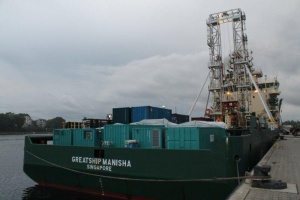
Mobile containers onboard the Greatship Manisha are located in the back deck of the drillship. ESO containers are equipped for core curation and laboratory facilities (petrophysics, geochemistry, microbiology) (A. Kotilainen @ECORD/IODP).
The restrictions onboard the vessel require flexible planning, both by scientists and drilling technicians. A limited number of 20-foot mobile containers are provided and equipped for core curation and some laboratory facilities. ESO carries the equipment necessary to conduct IODP minimum measurements. An overview of the equipment normally available offshore, or has been used on previous MSP expeditions, is available at the Bremen Core Repository website.
Comprehensive scientific analyses on the sediment cores are carried out during the onshore phase of the MSP, which takes place several months after the offshore operations have been completed. Consequently, only a few researchers and technicians, under the guidance of the Co-chief Scientists, are needed during the offshore phase. The small offshore team may have to help out on a range of scientific tasks to ensure that the essential work of capturing ephemeral measurements (i.e measurements that have to be taken shortly after the core is collected) are completed.
Photos of mission-specific platforms at sea: Exp 302 Arctic – Exp 310 Tahiti – Exp 313 New Jersey – Exp 325 Great Barrier Reef – Exp 347 Baltic – Exp 357 Atlantis Massif – Exp 364 Chicxulub – Exp 381 Corinth
Taking these factors into account, there is clear difference between MSP and other IODP expeditions in that there is the need to have an Onshore Science Party (OSP) following the offshore phase. The OSP is the real science party, not merely a sampling party.
The Onshore Science Party (OSP)
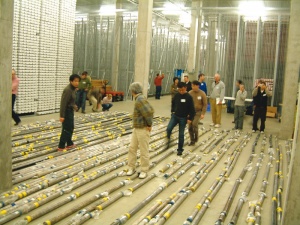
All cores retrieved during Expedition 310 are laid out in the refrigerated storage hall at Bremen Core Repository for general inspection before the OSP. (© ECORD/IODP).
The Onshore Science Party (OSP) takes place after the offshore operations are completed. The cores are transferred to the Bremen Core Repository (BCR) located at the University of Bremen in Germany, one of three IODP core repositories worldwide.
At the OSP, cores are split and scientists have their first opportunity to study the cores in detail, as they have access to the full laboratory facilities of the BCR. An essential requirement of the OSP is that scientists stay at the core repository until all core descriptions, initial measurements (IODP minimum measurements, and some IODP standard measurements), and report writing have been completed.
Core flow procedures at the Onshore Science Party.
The end of the OSP is the equivalent of coming off an IODP drillship. The entire invited expedition science party are required to attend the OSP and participants are asked to be flexible in their attitude to start and end dates. The start times may be influenced by any changes in the timing of the offshore phase, but the OSP normally takes place within 2-4 months of the end of the offshore operations. The duration of the OSP is in part dependent on the quantity of core collected.

